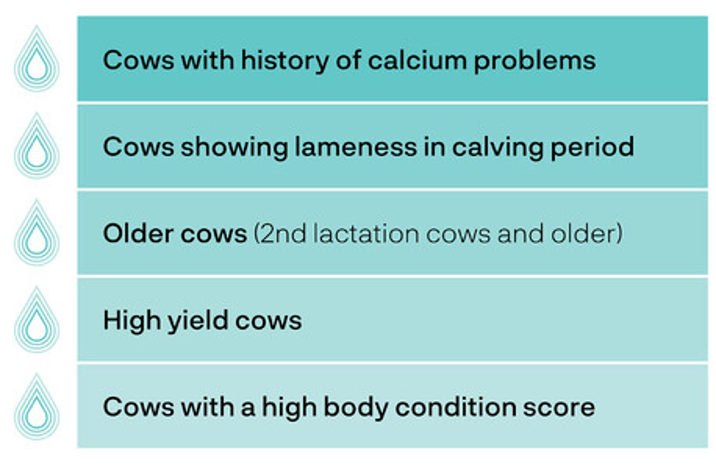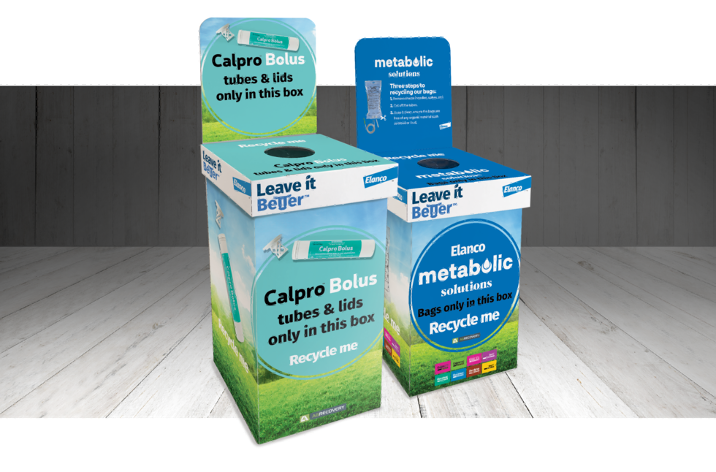The insidious, invisible problem – in NZ the average herd-level prevalence of subclinical hypocalcaemia is 52%**
Explaining Hypocalcaemia
At calving, a dairy cow must switch from being non-lactating (dry) to lactating (in-milk), rapidly adapting to the nutritional demands of milk production. A crucial mineral component of milk is calcium and at calving there is an immediate and increased requirement for calcium. Calcium is transported in the animal in the blood and it has several important roles including the mineralisation of bone and correct functioning of muscles. The sudden increased requirement for calcium at calving can lead to a measurable fall in blood calcium, referred to as hypocalcaemia. If the drop in blood calcium is severe it can lead to increasing paralysis of muscles and the serious clinical condition of Milk Fever (clinical hypocalcaemia). If left untreated, Milk fever leads to recumbency and potentially to the loss of the cow. By measuring the blood calcium level of cows without clinical signs of milk fever around calving, it has been shown that many still have a drop in blood calcium that results in serious health and productivity consequences (subclinical hypocalcaemia).

Fig. 1. Plasma concentrations of total calcium before and after calving. Data are from mature Jersey cows with clinical milk fever (n = 8) or without clinical milk fever (n = 19). (Data from Kimura K, Reinhardt TA, Goff JP. Parturition and hypocalcemia blunts calcium signals in immune cells of dairy cattle. J Dairy Sci 2006;89:2588-95.)
Consequences of Hypocalcaemia:

Subclinical Hypocalcaemia:
With increased demand to produce more milk, cows are under pressure around the calving period. Milk fever or hypocalcaemia is a disorder caused by low blood calcium levels. Milk fever occurs due to an imbalance between the cow’s demand for calcium and her ability to mobilise her calcium reserves quickly enough, progressing to ‘negative calcium balance’ and possibly culminating in clinical milk fever.
To get an idea of the magnitude of the problem, the production of 10kg of colostrum by the cow requires 23g of calcium. A cow producing 25kg of colostrum would have to replace her total blood calcium level every hour! To help animals cope with the delayed adjustment to the change in the demand for calcium, calcium boluses are proving to be both popular and effective.
Clinical milk fever
Around 5 to 7% of cows are affected by clinical milk fever in the first one to two days after calving. Signs can appear within 4 hours of calving and, if left untreated, can result in the death of the cow within 10-24 hours.
Clinical signs include:
- Cold extremities
- Low body temperature
- Dry Nose
- Poor appetite
- Constipation
- Unsteadiness leading to inability to stand
Sub-Clinical Milk Fever
Sub-clinical milk fever affects up to a further 52% of cows post calving.
Signs of sub-clinical milk fever post calving include:
- Calcium levels just below “adequate” levels
- Increased risk of culling
- Drop in blood calcium level
- Reduced productivity and immunity
Other Associated Issues
- Calving difficulties
- Retained foetal membranes
- Metritis
- Displaced abomasums (DA)
- Fertility - later returns and a drop in pregnancy rates
- Reduced milk yield
- Reduced feed intakes - energy related disorders such as, fatty liver or ketosis
The Calpro Bolus Solution
Use Calpro Bolus for the prevention and treatment of subclinical hypocalcaemia and as an aid in the prevention and treatment of clinical hypocalcaemia (Milk Fever) in cows. Calpro Bolus offers peace of mind because it is the only ACVM registered calcium bolus and is supported by a published, peer-reviewed New Zealand study*.
A combination of academic and industry research is behind the design of Calpro Bolus, which dissolves within 50 minutes, rapidly delivering 43g of calcium to the rumen. Calcium is released in two forms, calcium chloride and calcium sulphate (refer to Fig 2.)
What is of critical importance with any supplementary calcium is that it does not interfere with the innate control mechanisms. Freshly calved cows need to access both the supplementary calcium and their own reserves.
Calpro Bolus boluses support the calcium control mechanism by lowering urine pH so natural body reserves of calcium are more readily available to the animal and assisting absorption of the supplementary calcium from the bolus within 1 hour of administration.
All animals are susceptible to milk fever, but some are at greater risk: Cows that can benefit from Calpro Bolus:

Bolus Technology

Reducing the Risk
- Calpro Bolus has been backed by peer-reviewed research in New Zealand*.
- Calpro Bolus is the only ACVM authorised intra-ruminal calcium bolus in New Zealand - this ensures Calpro Bolus has the highest quality assurance standards, stewardship and approved manufacturing.
- Immediately after calving, cows experience high levels of calcium loss through milk and colostrum. At this time of peak demand for calcium, Calpro Bolus prevents and treats subclinical hypocalcaemia and is also an aid in the prevention and treatment of clinical hypocalcaemia (Milk Fever).
- Calpro Bolus delivers two essential types of calcium: chloride and sulphate. These two calcium ingredients have been proven to help get cows back to optimum performing levels***.
- Calcium chloride is rapidly absorbed, and the calcium sulphate is absorbed over a longer period.
- Peace of mind with the standard dose regime of two boluses administered 12 hours apart providing a sustained increase in serum calcium over 24 hours.
- Calpro Bolus dissolves completely in the reticulorumen. The coating of the bolus protects against irritation of the epithelial surface of the throat and oesophagus. Furthermore, the bolus has a neutral taste, which makes it easy to administer.
Calpro Bolus is only available from your local veterinary clinic.
Calpro Bolus Tube Recycling
Elanco have been working alongside Agrecovery to seek sustainable end-of-life management solutions for our product packaging.

Collect your empty Calpro Bolus Tubes and lids.
Ensure they are clean and free of contamination.
Drop them in to your participating Vet Clinic for recycling.

Chart adapted from Kimura K, Reinhardt TA, Goff JP. Parturition and hypocalcaemia blunts calcium signals in immune cells of dairy cattle. J Dairy Sci 2006;89:2588–95
*KI Roberts, J Bennison & S McDougall (2019) Effect of treatment with oral Ca boluses following calving on concentrations of Ca in serum in pasture-based dairy cows, New Zealand Veterinary Journal, 67:1, 20-26, DOI: 10.1080/00480169.2018.15206542
**KI Roberts & S McDougall (2019) Risk factors for subclinical hypocalcaemia, and associations between subclinical hypocalcaemia and reproductive performance, in pasture-based dairy herds in New Zealand, New Zealand Veterinary Journal, 67:1, 12-19, DOI: 10.1080/00480169.2018.1527732
***Goff JP. The monitoring, prevention and treatment of milk fever and subclinical hypocalcaemia in dairy cows. Vet J 2008;176(1):50–57
Calpro Bolus is registered under the ACVM Act 1997, No. A011667.
Calpro Bolus, Leave it Better, Elanco and the diagonal bar logo are trademarks of Elanco or its affiliates.